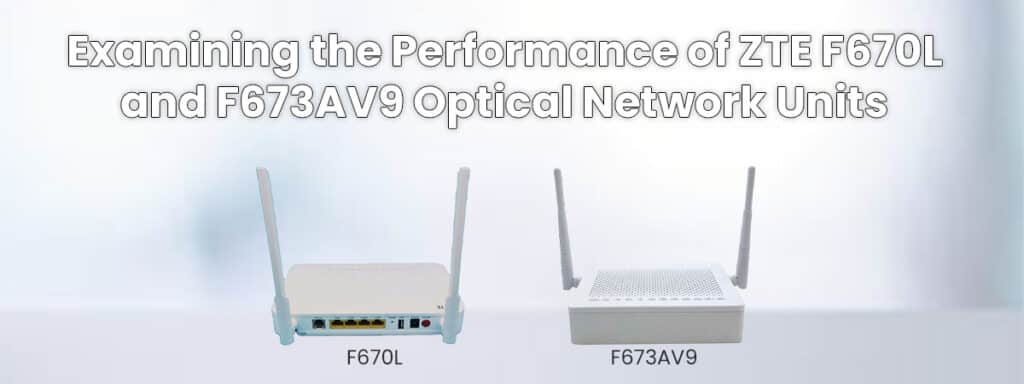Introduction
The ZTE F670L and F673AV9 Optical Network Units (ONUs) are two of the most popular products in the market today. Both are designed to provide businesses with high-performing, reliable, and cost-effective solutions for their communication needs. Both models come with a host of features that make them ideal for a variety of applications, ranging from enterprise and consumer networks to telecommunication and cable broadcasting. In this article, we will compare the ZTE F670L and F673AV9 ONUs, and discuss their features, advantages, and disadvantages.
Overview of ZTE F670L
The ZTE F670L is a multi-service access device (MSAD) designed for optical network applications. It supports Gigabit Passive Optical Network (GPON) and Ethernet Passive Optical Network (EPON) technologies. It also supports a variety of voice, data, and video services. The F670L can be used as a residential gateway, providing users with access to high-speed Internet and telephone services. It also supports Ethernet, Wi-Fi, and VoIP services. It has a Gigabit Ethernet port that can be used to connect to other devices, such as IP cameras or computers.
The F670L is designed with an advanced hardware architecture, which makes it capable of delivering high-speed services with low latency. It supports up to four GPON ports and up to eight EPON ports. The F670L also supports advanced features such as Quality of Service (QoS), Class of Service (CoS), and Service Level Agreements (SLA). It also supports Layer 2 and Layer 3 protocols, making it suitable for enterprise networks as well as residential networks.
Overview of ZTE F673AV9
The ZTE F673AV9 is a multi-service access device (MSAD) for optical network applications. It supports Gigabit Passive Optical Network (GPON) and Ethernet Passive Optical Network (EPON) technologies. It also supports a variety of voice, data, and video services. The F673AV9 can be used as a residential gateway, providing users with access to high-speed Internet and telephone services. It also supports Ethernet, Wi-Fi, and VoIP services. It has a Gigabit Ethernet port that can be used to connect to other devices, such as IP cameras or computers.
The F673AV9 has an advanced hardware architecture that enables it to deliver high-speed services with low latency. It supports up to four GPON ports and up to eight EPON ports. Unlike the F670L, the F673AV9 supports advanced features such as Quality of Service (QoS), Class of Service (CoS), and Service Level Agreements (SLA). It also supports Layer 2 and Layer 3 protocols, making it suitable for enterprise networks as well as residential networks.
Network Protocols and Security
Both the ZTE F670L and F673AV9 support Layer 2 and Layer 3 protocols. The F670L supports the IEEE 802.1Q VLAN tagging, which allows for the creation of virtual networks within a single physical network. It also supports the IEEE 802.1p Quality of Service (QoS) standard, which enables the prioritization of network traffic. The F673AV9 also supports the IEEE 802.1Q VLAN and IEEE 802.1p QoS protocols.
Both the F670L and F673AV9 have built-in security features. The F670L supports the IEEE 802.1x port-based authentication protocol, which enables users to authenticate themselves before accessing the network. The F673AV9 also supports the IEEE 802.1x port-based authentication protocol, as well as the IEEE 802.2x MAC-based authentication protocol. Both devices also support the Secure Sockets Layer (SSL) protocol, which ensures secure data transmission.
Performance
The ZTE F670L and F673AV9 both offer high performance. The F670L supports up to four GPON ports and up to eight EPON ports, and it has a maximum throughput of 2.5 Gbps. The F673AV9 also supports up to four GPON ports and up to eight EPON ports, and it has a maximum throughput of 2.5 Gbps. Both devices support voice, data, and video services, and they have a low latency of less than 1 ms.
Conclusion
The ZTE F670L and F673AV9 are two of the most popular Optical Network Units (ONUs) in the market today. Both devices offer high performance, reliability, and cost savings, making them ideal for businesses of all sizes. The F670L is designed for residential networks, while the F673AV9 is designed for enterprise networks. Both devices support a variety of voice, data, and video services, and they have a low latency of less than 1 ms. The F670L is more affordable than the F673AV9, but the F673AV9 offers more advanced features, such as Quality of Service (QoS), Class of Service (CoS), and Service Level Agreements (SLA). Both devices also support Layer 2 and Layer 3 protocols, as well as built-in security features. In summary, the ZTE F670L and F673AV9 are both excellent choices for businesses looking for high-performing, reliable, and cost-effective solutions for their communication needs.

